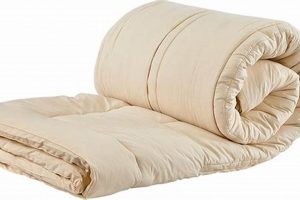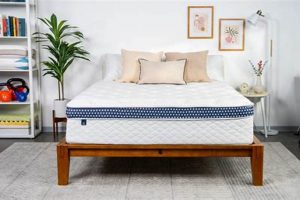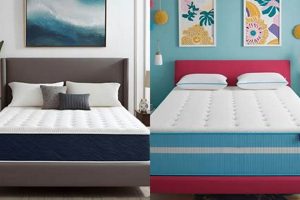A sleep surface engineered to provide optimal support, comfort, and durability for individuals weighing around 300 pounds is a crucial investment in restful sleep and long-term physical well-being. These mattresses typically incorporate features like reinforced coil systems, high-density foams, and robust construction materials to prevent sagging and ensure proper spinal alignment. A suitable example would be a hybrid mattress with a strong innerspring core and several layers of high-density memory foam or latex.
The selection of a proper sleep surface significantly impacts sleep quality, pressure point relief, and spinal health. Individuals in this weight range often experience greater compression on standard mattresses, leading to discomfort, pain, and disrupted sleep patterns. Historically, individuals with higher body weights faced limited options, but advancements in mattress technology now offer solutions specifically designed to accommodate their unique needs. These specialized mattresses offer enhanced support, longevity, and ultimately, a more restorative sleep experience.
The subsequent discussion will delve into the specific features and materials that contribute to the effectiveness of a supportive and comfortable sleep surface for individuals in this weight category. Considerations such as coil count, foam density, edge support, and overall mattress construction will be examined to provide a comprehensive understanding of what to look for when selecting the ideal mattress.
Essential Considerations for a Supportive Sleep Surface
Selecting the correct sleep surface is paramount for individuals requiring enhanced support and durability. The following tips outline crucial factors to consider during the purchase process.
Tip 1: Prioritize Innerspring Coil Count and Gauge: A higher coil count, coupled with a lower gauge (thicker wire), indicates a more supportive and durable core. Target mattresses with at least 400 coils for a queen size, and consider pocketed coils to minimize motion transfer.
Tip 2: Opt for High-Density Foam Layers: Foam density is a critical determinant of longevity. Look for mattresses with comfort layers utilizing high-density memory foam or latex (at least 4 lbs per cubic foot for memory foam and 6 lbs per cubic foot for latex). These materials resist compression and maintain their shape over time.
Tip 3: Evaluate Edge Support Construction: Robust edge support prevents sagging and provides a stable sleeping surface across the entire mattress. Reinforced edges, often constructed with high-density foam encasements or steel perimeter supports, are essential.
Tip 4: Examine Mattress Construction and Materials: Carefully review the materials used throughout the entire mattress, paying attention to the quality of the cover, support core, and transition layers. Durable and breathable materials contribute to both comfort and longevity.
Tip 5: Consider Hybrid Mattress Designs: Hybrid mattresses combine the benefits of innerspring support with the conforming comfort of foam layers. This design often provides an optimal balance of support and pressure relief for individuals requiring enhanced support.
Tip 6: Research Mattress Firmness Levels: Firmness is subjective, but generally, individuals requiring enhanced support benefit from firmer mattresses. Explore options ranging from firm to extra-firm, taking into account personal preference and sleeping position.
Tip 7: Investigate Warranty and Trial Periods: A comprehensive warranty protects against manufacturing defects and premature sagging. Additionally, a generous trial period allows ample time to assess the mattress’s suitability and comfort.
Selecting a mattress based on these criteria will contribute to improved sleep quality, spinal alignment, and overall physical well-being.
The subsequent section will address common misconceptions and further refine the selection process to ensure optimal satisfaction.
1. Reinforced Coil Systems
Reinforced coil systems are a critical component in sleep surfaces designed for individuals requiring enhanced support, particularly those around 300 pounds. The design and construction of these systems directly impact the mattress’s ability to provide adequate support, maintain spinal alignment, and resist sagging over time. Their presence is a primary differentiator between a standard mattress and one specifically engineered for heavier individuals.
- Coil Gauge and Support
Coil gauge refers to the thickness of the wire used in the innerspring system. A lower gauge number indicates a thicker, sturdier coil. For individuals around 300 pounds, a lower gauge coil (e.g., 13-gauge or lower) is preferable as it provides greater resistance to compression. Thicker coils offer more robust support, preventing the mattress from bottoming out and ensuring proper spinal alignment. Mattresses with thinner coils (higher gauge numbers) are more likely to sag prematurely, leading to discomfort and potential back pain.
- Coil Count and Weight Distribution
Coil count refers to the number of individual coils within the mattress. While coil count alone isn’t the sole determinant of support, a higher coil count, in conjunction with a lower gauge, generally indicates a more supportive and durable mattress. A higher coil count facilitates better weight distribution across the sleep surface, reducing pressure points and preventing localized sagging. This is especially important for individuals with higher body weights as it ensures even support across the entire sleeping area.
- Coil Type and Motion Isolation
Various coil types exist, including Bonnell coils, continuous coils, and pocketed coils (also known as Marshall coils). Pocketed coils are often preferred in mattresses for heavier individuals due to their ability to contour to the body and provide targeted support. Each coil is individually wrapped in fabric, allowing them to move independently. This minimizes motion transfer, preventing disturbances caused by a partner’s movements. Bonnell coils, while less expensive, provide less targeted support and may result in greater motion transfer.
- Zoned Support Systems
Some reinforced coil systems incorporate zoned support, where different sections of the mattress have varying coil densities or gauges. This design allows for targeted support to specific areas of the body, such as the lumbar region, where additional support is often needed. Zoned support systems can help maintain spinal alignment and alleviate pressure points, contributing to a more comfortable and restorative sleep experience.
In summary, the implementation of reinforced coil systems, with a focus on low coil gauge, high coil count, pocketed coil technology, and zoned support, directly enhances the suitability of a mattress for individuals around 300 pounds. These features collectively contribute to improved support, durability, and comfort, addressing the specific needs of this demographic and maximi
zing the long-term value of the mattress.
2. High-Density Foam Layers
High-density foam layers are a crucial component in a mattress designed for individuals around 300 pounds, significantly affecting its performance and longevity. The density of the foam directly correlates with its ability to resist compression and provide consistent support over time. Standard foam densities often break down quickly under higher weights, leading to sagging and discomfort. High-density foam, conversely, maintains its structural integrity, providing sustained support to the sleeper’s body and preventing the formation of pressure points. For instance, a mattress utilizing high-density memory foam (4 lbs/cubic foot or greater) or high-density latex (6 lbs/cubic foot or greater) will demonstrably outperform lower-density alternatives in resisting compression and maintaining its shape under consistent use by a heavier individual.
The practical significance of utilizing high-density foam layers extends beyond mere comfort. Proper support ensures spinal alignment, reducing the risk of back pain and promoting more restful sleep. A mattress that sags prematurely forces the body into unnatural positions, leading to muscle strain and discomfort. High-density foam, by maintaining its form, actively supports the spine’s natural curvature, minimizing these issues. Furthermore, the longevity of the mattress is directly tied to the density of its foam layers. A mattress with high-density foam is an investment in long-term sleep quality and avoids the need for frequent replacements, which can be costly and disruptive.
In summary, high-density foam layers are essential for mattresses intended for individuals around 300 pounds. They directly contribute to the mattress’s support, durability, and ability to maintain spinal alignment. This understanding of the correlation between foam density and mattress performance is critical in selecting a sleep surface that provides both immediate comfort and long-term value, ultimately contributing to improved sleep quality and overall physical well-being. Neglecting this factor can result in discomfort, premature mattress failure, and potential health concerns.
3. Robust Edge Support
Robust edge support is a critical component in a mattress designed for individuals weighing around 300 pounds. Without sufficient edge support, the perimeter of the mattress collapses under pressure, reducing the usable sleeping surface and creating a feeling of instability, particularly when sitting or lying near the edge. This is especially relevant for larger individuals who may naturally gravitate towards the edge of the bed or require the full surface area for comfortable sleep. The structural integrity of the mattress perimeter directly influences the user’s sense of security and comfort, impacting overall sleep quality. A lack of edge support also accelerates wear and tear, shortening the mattress’s lifespan and diminishing its value as an investment. A real-life example would be an individual finding themselves rolling off the side of a mattress lacking proper edge reinforcement, leading to disrupted sleep and potential injury. Understanding this connection between edge support and user experience is paramount.
The practical implications of robust edge support extend beyond the immediate sleeping experience. Consider situations where individuals utilize the edge of the bed for dressing, reading, or simply getting in and out of bed. A strong edge prevents sagging and provides a stable platform for these activities, improving accessibility and reducing strain on joints. Further, robust edge support contributes to the overall longevity of the mattress. By preventing the edges from collapsing, the internal components are better protected from stress and distortion, leading to a more uniform distribution of weight across the entire mattress surface. This uniform weight distribution minimizes localized wear and extends the mattress’s usable lifespan, making it a more cost-effective choice over time. Mattresses with reinforced edges, often achieved through high-density foam encasements or steel perimeter supports, demonstrate a measurable improvement in durability and user satisfaction.
In summary, robust edge support is not a mere aesthetic feature but an integral element of a quality mattress designed for heavier individuals. It contributes significantly to comfort, usability, and longevity. The absence of adequate edge reinforcement leads to a reduced sleeping surface, instability, accelerated wear, and a diminished overall sleep experience. Prioritizing mattresses with robust edge support is essential for individuals around 300 pounds seeking a durable, comfortable, and supportive sleep surface. It is an investment in lasting comfort and long-term value, mitigating the challenges associated with premature mattress degradation and enhancing overall sleep quality.
4. Durable Construction Materials
The correlation between durable construction materials and the suitability of a sleep surface for individuals around 300 lbs is direct and consequential. A mattress designed for this weight range experiences significantly higher levels of stress and compression compared to standard mattresses. The selection of inherently durable materials, therefore, is not a mere enhancement but a fundamental requirement for ensuring adequate support, longevity, and sustained comfort. Premature sagging, foam degradation, and coil failure are common issues in mattresses constructed with substandard materials, leading to discomfort, spinal misalignment, and a shortened lifespan. For example, a mattress using low-density foam in its comfort layers will quickly lose its shape and support under consistent pressure, resulting in a hammock-like sleeping surface that exacerbates back pain. The practical significance of selecting durable materials lies in preventing these issues and maximizing the return on investment in a quality sleep surface.
Further analysis reveals the specific materials that contribute to a mattress’s overall durability. High-density memory foam (4 lbs/cubic foot or greater) and latex (6 lbs/cubic foot or greater) demonstrate superior resistance to compression and are essential for the comfort layers. In the support core, tempered steel coils with a lower gauge (thicker wire) provide robust support and prevent sagging. The mattress cover should be constructed from durable, breathable fabrics like cotton or reinforced polyester blends to withstand wear and tear. Seams and stitching should be reinforced to prevent separation and maintain the mattress’s structural integrity. The choice of these materials, combined with quality craftsmanship, directly impacts the mattress’s ability to maintain its shape, support, and comfort over an extended period. Failure to prioritize these material specifications results in a product that is ultimately unsuitable for its intended purpose.
In summary, durable construction materials are not merely desirable features but essential components of a mattress designed for individuals around 300 lbs. The selection of high-density foams, tempered steel coils, and durable fabrics directly impacts the mattress’s ability to provide sustained support, resist saggin
g, and maintain its shape over time. This understanding is crucial for making informed purchasing decisions and avoiding the pitfalls of premature mattress failure. By prioritizing durable materials, individuals can ensure a more comfortable, supportive, and long-lasting sleep experience, mitigating the challenges associated with weight-related mattress degradation and improving overall sleep quality.
5. Optimal Firmness Level
Determining the optimal firmness level is a pivotal aspect of selecting a sleep surface suitable for individuals weighing approximately 300 pounds. Firmness directly impacts spinal alignment, pressure distribution, and overall comfort, each of which is crucial for ensuring restful sleep and mitigating potential musculoskeletal issues. A mattress that is too soft will lack adequate support, leading to spinal misalignment and potential back pain. Conversely, a mattress that is too firm may create excessive pressure points, causing discomfort and disrupting sleep. Establishing the correct firmness level is therefore a balancing act, requiring consideration of individual preferences, sleeping positions, and the specific needs associated with a higher body weight.
- Spinal Alignment and Firmness
The primary function of a supportive sleep surface is to maintain proper spinal alignment throughout the night. For individuals around 300 pounds, a firmer mattress is often necessary to prevent excessive sinking, which can lead to spinal curvature and discomfort. A medium-firm to firm mattress generally provides the necessary support to keep the spine in a neutral position, particularly for back and stomach sleepers. Side sleepers, however, may require a slightly softer surface to allow for adequate shoulder and hip contouring while still maintaining spinal alignment. A lack of spinal alignment can result in chronic back pain, muscle stiffness, and a diminished quality of sleep.
- Pressure Distribution and Firmness
Firmness directly influences pressure distribution across the body. A mattress that is too firm can create concentrated pressure points, particularly at the hips, shoulders, and knees. These pressure points can restrict blood flow and cause discomfort, leading to tossing and turning throughout the night. Conversely, a mattress that is too soft may not provide enough support, resulting in uneven weight distribution and pressure buildup in the lower back. The optimal firmness level distributes weight evenly across the sleep surface, minimizing pressure points and promoting circulation. Memory foam and latex materials, when combined with an appropriate firmness level, can further enhance pressure relief by conforming to the body’s contours.
- Sleeping Position and Firmness Preference
Sleeping position is a significant determinant of the ideal firmness level. Back sleepers typically benefit from a medium-firm to firm mattress, which provides adequate support for the lower back and prevents the spine from sagging. Side sleepers generally prefer a slightly softer mattress that allows the shoulders and hips to sink in, maintaining spinal alignment. Stomach sleepers often require a firm mattress to prevent excessive arching of the lower back. Individuals who change positions frequently throughout the night may find a medium-firm mattress to be the most versatile option. The firmness level should accommodate the individual’s primary sleeping position while providing adequate support and pressure relief.
- Weight Distribution and Firmness Perception
An individual’s weight significantly impacts how they perceive mattress firmness. Individuals around 300 pounds exert greater pressure on the mattress, causing it to feel softer than it would to a lighter person. Consequently, a mattress labeled as “medium-firm” may feel softer to a heavier individual than it would to someone of average weight. It is therefore crucial for individuals in this weight range to select a mattress with a firmness level that accounts for their weight, often requiring a firmer option than they might otherwise choose. Considering weight distribution ensures that the mattress provides the necessary support and prevents premature sagging, thereby maximizing comfort and longevity.
The interrelationship between spinal alignment, pressure distribution, sleeping position, and weight distribution underscores the importance of carefully selecting the optimal firmness level. A misjudged firmness can negate other positive attributes of a mattress, such as durable construction or advanced materials. By understanding these interconnected factors, individuals around 300 pounds can make informed decisions that promote restful sleep, minimize discomfort, and ensure the long-term suitability of their chosen sleep surface.
6. Extended Warranty Coverage
Extended warranty coverage assumes heightened importance in the context of selecting a sleep surface for individuals weighing approximately 300 pounds. Standard warranties often provide insufficient protection against the accelerated wear and tear that heavier individuals impart on a mattress. The presence of a comprehensive extended warranty serves as a critical safeguard against premature degradation and ensures the long-term value of the investment.
- Protection Against Sagging and Body Impressions
Sagging and body impressions are common issues in mattresses that are consistently subjected to higher weight loads. An extended warranty should specifically address these concerns, providing recourse if the mattress develops indentations exceeding a specified depth within the warranty period. Without such protection, individuals may find themselves with a significantly degraded sleep surface long before the mattress’s expected lifespan, negating the benefits of any other features.
- Coverage for Coil or Support System Failure
The support system, whether composed of innerspring coils or dense foam, is the backbone of any mattress. For individuals around 300 pounds, this system is under constant stress. An extended warranty should provide coverage for coil breakage, loss of coil support, or significant deformation of the foam support core. This protection ensures that the mattress continues to provide adequate support and maintain spinal alignment throughout its usable life.
- Protection Against Manufacturing Defects
Even with high-quality materials and construction, manufacturing defects can occur. An extended warranty provides a safeguard against such defects, covering issues like faulty seams, uneven foam distribution, or substandard materials that lead to premature failure. This protection ensures that the consumer is not held responsible for issues arising from the manufacturer’s errors.
- Long-Term Cost Savings and Peace of Mind
While an extended warranty may represent an upfront cost, it can result in significant long-term savings. Replacing a prematurely degraded mattress can be a substantial expense. The extended warranty provides peace of mind, knowing that the investment is protected against unexpected failures. It also reflects the manufacturer’s confidence in the quality and durability of their product, signaling a commitment to customer satisfaction.
In summary, extended warranty coverage is a non-negotiable aspect of selecting a
sleep surface for individuals weighing approximately 300 pounds. It provides essential protection against common weight-related issues, safeguarding the investment and ensuring long-term comfort and support. Without this coverage, the risk of premature mattress failure and associated costs is significantly increased, undermining the benefits of even the most advanced mattress technologies.
7. Adequate Thickness (Height)
Adequate mattress thickness, often referred to as height, plays a crucial role in providing optimal support and comfort, particularly for individuals weighing around 300 pounds. Insufficient thickness can compromise the mattress’s ability to effectively distribute weight, maintain spinal alignment, and prevent bottoming out. The following points detail the critical aspects of mattress thickness in this specific context.
- Support Core Compression
A mattress of inadequate thickness may lack a sufficient support core to prevent compression under higher weight loads. The support core, typically composed of innerspring coils or high-density foam, is responsible for maintaining the mattress’s structure and providing the primary source of support. A thinner mattress will experience greater compression of this core, leading to a loss of support, sagging, and potential discomfort. An individual weighing around 300 pounds requires a thicker support core to ensure that the mattress maintains its shape and provides consistent support over time. A mattress with a thin support core will likely degrade more rapidly and fail to provide adequate spinal alignment.
- Comfort Layer Depth
Thickness also dictates the depth of the comfort layers, which are responsible for providing pressure relief and contouring to the body. A thinner mattress may have insufficient comfort layers to effectively cushion pressure points, leading to discomfort and disrupted sleep. Individuals weighing around 300 pounds often require deeper comfort layers to distribute their weight evenly and prevent concentrated pressure on specific areas, such as the hips and shoulders. Adequate thickness in the comfort layers ensures that the sleeper does not “bottom out” on the support core, which can be particularly uncomfortable and detrimental to spinal health.
- Overall Durability and Longevity
Mattress thickness is directly related to its overall durability and lifespan, especially for heavier individuals. A thicker mattress typically contains more material and is built with a more robust construction, making it more resistant to wear and tear. The increased thickness provides additional support and reduces the stress on individual components, such as coils and foam layers. A thinner mattress, conversely, is more prone to premature sagging, compression, and breakdown, resulting in a shorter lifespan and the need for more frequent replacement. Investing in a thicker mattress is often a more cost-effective choice in the long run, as it provides better support and lasts longer.
- Ease of Entry and Exit
Thickness affects the overall height of the bed, influencing the ease of getting in and out. A mattress that is too thin may result in a bed that is too low to the ground, making it difficult for some individuals to enter and exit comfortably. This can be particularly problematic for individuals with mobility issues or joint pain. Adequate mattress thickness, combined with an appropriate bed frame height, ensures a comfortable and accessible sleeping surface. Conversely, an excessively thick mattress on a high bed frame may also create accessibility challenges. The ideal thickness should be considered in conjunction with the bed frame to achieve a comfortable and ergonomic height.
In summary, adequate mattress thickness is a critical factor in ensuring optimal support, comfort, durability, and accessibility for individuals weighing around 300 pounds. It directly impacts the support core’s ability to resist compression, the comfort layers’ capacity to provide pressure relief, the mattress’s overall lifespan, and the ease of getting in and out of bed. Selecting a mattress with appropriate thickness is a crucial step in creating a supportive and comfortable sleep environment.
Frequently Asked Questions
This section addresses common inquiries regarding the selection of appropriate mattresses for individuals weighing approximately 300 pounds, offering concise and informative answers based on established industry standards and best practices.
Question 1: Why is a specialized mattress necessary for individuals around 300 lbs?
Standard mattresses are often not engineered to withstand the consistent compression and stress imposed by higher body weights. This can lead to premature sagging, inadequate support, and a reduced lifespan. Specialized mattresses incorporate reinforced components and durable materials to address these specific challenges, ensuring proper spinal alignment and long-term comfort.
Question 2: What is the recommended firmness level for this weight range?
A medium-firm to firm mattress is generally recommended to provide adequate support and prevent excessive sinking. However, individual sleeping positions and preferences should also be considered. Back and stomach sleepers typically benefit from firmer options, while side sleepers may prefer a slightly softer surface to allow for shoulder and hip contouring.
Question 3: What key features should be prioritized when selecting a mattress?
Prioritize mattresses with reinforced coil systems (low gauge and high count), high-density foam layers (at least 4 lbs/cubic foot for memory foam and 6 lbs/cubic foot for latex), robust edge support, and durable construction materials. Adequate mattress thickness and an extended warranty are also crucial considerations.
Question 4: How does foam density impact mattress performance?
Foam density directly correlates with its ability to resist compression and provide consistent support over time. High-density foams maintain their shape and prevent sagging, while low-density foams break down more quickly under higher weight loads, resulting in discomfort and reduced support.
Question 5: Is edge support a critical factor?
Yes. Robust edge support prevents the perimeter of the mattress from collapsing, expanding the usable sleeping surface and providing a stable platform for sitting or getting in and out of bed. It also contributes to the overall longevity of the mattress.
Question 6: What type of warranty coverage is considered adequate?
An extended warranty that specifically addresses sagging, body impressions, coil or support system failure, and manufacturing defects is highly recommended. This coverage provides protection against common weight-related issues and ensures the long-term value of the investment.
These FAQs underscore the importance of selecting a mattress specifically designed to accommodate the needs of individuals weighing around 300 pounds. Attention to key features, material quality, and warranty coverage will contribute to a more comfortable, supportive, and durable sleep experience.
The following section will present specific mattress recommendations based on the factors discussed.
Concluding Remarks on Selecting a Mattress for Individuals Weighing Approximately 300 lbs
The preceding analysis has illuminated the critical factors that define a suitable sleep surface f
or individuals within this weight range. The exploration encompassed reinforced support systems, high-density materials, robust edge construction, optimal firmness considerations, and the importance of comprehensive warranty coverage. Each of these elements contributes significantly to the mattress’s ability to provide adequate support, maintain spinal alignment, and ensure long-term durability, directly impacting the quality of sleep and overall physical well-being. The suitability of a sleep surface is not merely a matter of comfort, but a foundational element of health and restorative rest.
The information presented serves as a guide for informed decision-making. Prospective purchasers are encouraged to rigorously evaluate mattresses against these established criteria. Selecting the appropriate mattress is an investment in both immediate comfort and long-term health, and should be approached with careful consideration of the factors outlined. The ultimate goal is to secure a sleep environment that provides optimal support, promotes restful sleep, and contributes to a healthier lifestyle.







![Top-Rated Best Truck Bed Mattress Options [Guide] Organic & Natural Mattress Buyer’s Guide: Non-Toxic Sleep Solutions Top-Rated Best Truck Bed Mattress Options [Guide] | Organic & Natural Mattress Buyer’s Guide: Non-Toxic Sleep Solutions](https://mattressworldpa.com/wp-content/uploads/2025/07/th-7704-300x200.jpg)